En els darrers 25 anys s’ha viscut una evolució en banca que es reflecteix, entre molts altres aspectes, en els crèdits documentaris. A ESCI-UPF també s’han viscut aquests canvis dins les aules.
En el decurs de la meva vida he donat ja diverses vegades la volta al sol, que és una forma literària que se m’acaba d’acudir per dir que ja no sóc un xaval.
Vaig entrar en el món de les operacions internacionals estudiant al CEDEIN (Centro de Estudios de Economía Internacional), una escola creada per la Cambra de Comerç de Barcelona i on després vaig ser professor i que fou, en definitiva, el bressol del qual naixeria ESCI-UPF.
Les meves primeres passes amb els crèdits documentaris van ser cap el 1972, quan estaven en vigor les UCP 222 i els crèdits documentaris s’emetien en paper, utilitzant uns formularis estandarditzats de diversos colors. Tot just un parell d’anys després, quan ja començava a dominar els 46 articles de les Regles, les van revisar i al 1974 em vaig haver d’adaptar a les UCP 290. Era la primera modificació a la que vaig haver de fer front, però no seria pas l’única. La segona va arribar amb la revisió de 1983, quan van veure la llum les UCP 400. I deu anys després, al 1993, un altre canvi per passar a les UCP 500.
I a la vegada que aquesta darrera modificació, va néixer ESCI-UPF.
Sé amb exactitud la data de la meva incorporació a aquesta universitat perquè sóc de guardar-ho tot, també totes les meves agendes professionals. Així que puc assegurar que el dia 24 d’abril del 1998 vaig tenir una primera reunió amb el Sr. José Julio Rodríguez, director de Formació Continua d’ESCI-UPF. En aquesta reunió vam acordar la meva incorporació com a professor al programa “Estrategias de Internacionalización de la Empresa”, del que encara en guardo un fulletó.
En aquells anys, els docents treballàvem encara a la pissarra, escrivint amb guix i els alumnes feien servir paper i bolígraf. Uns anys després, van arribar les transparències i no va ser fins mes tard, que es van utilitzar els llapis de memòria i els powerpoint, mentre que els alumnes van canviar el paper per portàtils i tauletes.
Els crèdits documentaris s’emetien per tèlex i no va ser fins a principis dels 90 que es va generalitzar la xarxa de Swift. Cap al 2001 es van complementar les Regles dels crèdits documentaris amb el suplement e-UCP per a presentacions electròniques. I al 2007 es va dur a terme una nova revisió que va donar pas a les UCP 600, que són les que encara avui ensenyem a ESCI-UPF.
En el decurs d’aquests anys, he escrit força articles relatius als crèdits documentaris, tant per a revistes en espanyol, com per a revistes en anglès. I mentre seguim donant voltes al sol, se m’ha acudit escriure aquest homenatge als que ens van precedir en el món dels negocis internacionals.
Paying Homage to Vienna 1933
A handful of entrepreneurs decided in 1919 to create an organization that would represent business everywhere. Some years later, their vision became reality. Let’s allow our imagination take us to Vienna on 1933.
It was February 11th. One of those cold Vienna winter days. At this point the group had grown to 20 or 30 merchants of peace gathered around a table, clad in dark suits with vests, sporting pocket watches with chains, hats and coats draped on hangers… And on the central table of that great hall, a pair of inkwells, pens, blotting papers and a few sheets of paper marked in red lettering “Proposal for a Uniform Customs and Practice for Commercial Documentary Credits”.
The assembled ones were trying to improve and update the Uniform Regulation for Commercial Documentary Credit that had been approved in Amsterdam on 13 July 1929. Smoky cups of coffee and tea accompanied the long discussions. The result of this meeting was the first Uniform Customs and Practice for Commercial Documentary Credits (UCP 82) which has been revised over time.
But what did this first set of rules say? How has it changed over time? Now 85 years after its initial publication, the time has come to pay homage to UCP. And the best way is to remember Vienna 1933 and the legacy it launched.
In this first edition of the Uniform Customs and Practice for Commercial Documentary Credits, no mention was made, of course, of electronic documents. The second paragraph of Article 9 of UCP 82 began by stating: “When a correspondent is instructed by cable or telegram to notify such Letter of Credit…”. Consider how far the world has come from cables and telegrams!
It was 69 years later, in April 2002, when the Supplement to UCP for Electronic Presentation (eUCP) came into effect. In the preface to that supplement, then-Chairman of the Commission, Dieter Kiefer, wrote: “The completion of the UCP Supplement for Electronic Presentation (eUCP) brings the documentary credit into the electronic age.” And since then we have witnessed the birth of a series of platforms that have sought to channel and perhaps monopolize the traffic of these electronic presentations, but in my opinion with little success.
Many small and medium-sized businesses operating in the world of international trade are not yet ready for this new electronic age. However, there is a possibility that the original paper documents required in a documentary credit are scanned. And all companies, even the smaller ones, have that capacity.
We now enter the debate: A document scanned from the original, can it be considered an electronic record? Let’s see what eUCP Version 1.1 says: “‘Electronic record’ means data created, generated, sent, communicated, received or stored by electronic means that is capable of being authenticated as to the apparent identity of a sender and the apparent source of the data contained in it, and as to whether it has remained complete and unaltered, and is capable of being examined for compliance with the terms and conditions of the eUCP credit.”
And the scanning of an original document is sent and received by electronic means? And the scanning of an original document shows the source and is unaltered? And the scanning of an original document is capable of being examined for compliance? If all three questions are being answered yes, would we agree that the scanning of an original document can be considered an electronic record? Again if we agree, the possibility for small businesses to use credits subject to the eUCP supplement would be immense.
But let’s continue analysing. With the documents scanned, it is very possible that importers/applicants could not dispatch the electronic records at their respective customs offices. They continue to need the original documents. Nothing would prevent the exporter from submitting the originals directly to their importing client once the electronic presentation was accepted.
These considerations would surely astonish those visionaries who, sitting around a table in Vienna, were working to draft the first set of uniform rules. This article serves as a tribute to how far those pioneers have taken us and how far we still have to go.



Leave a message